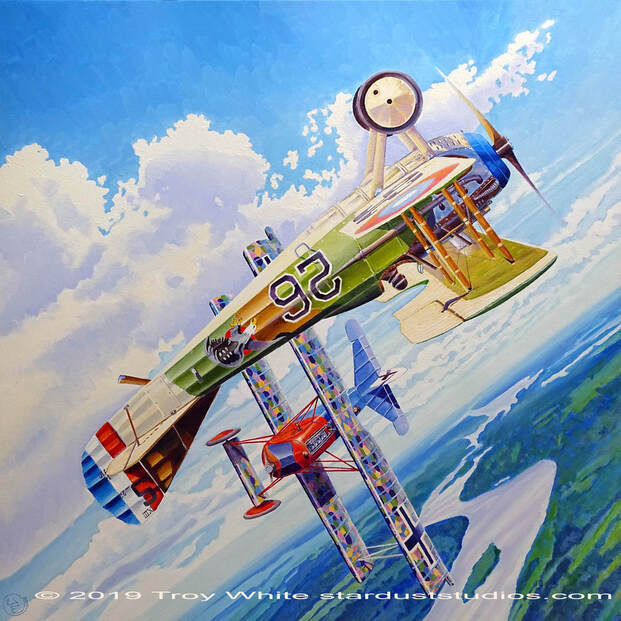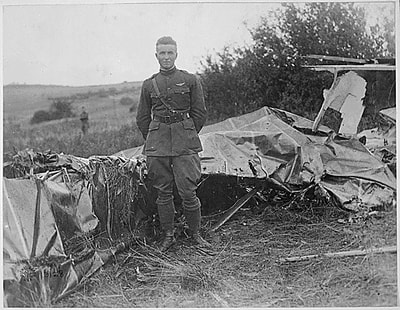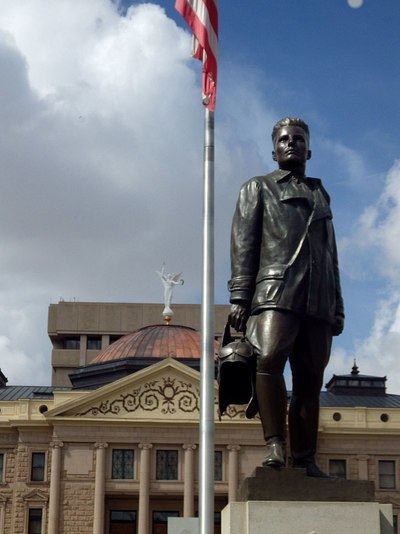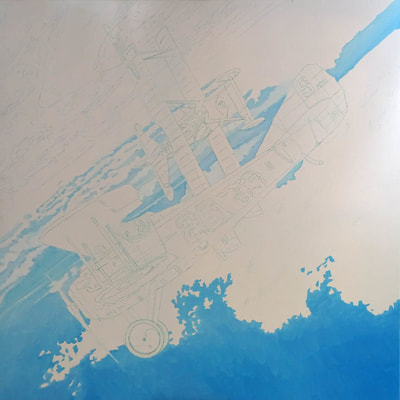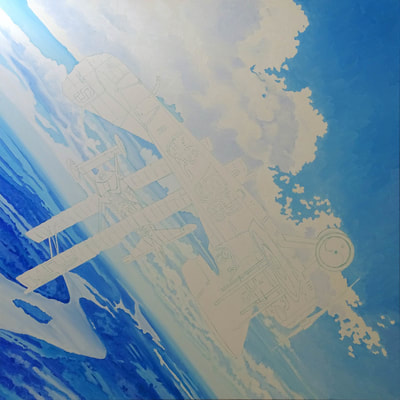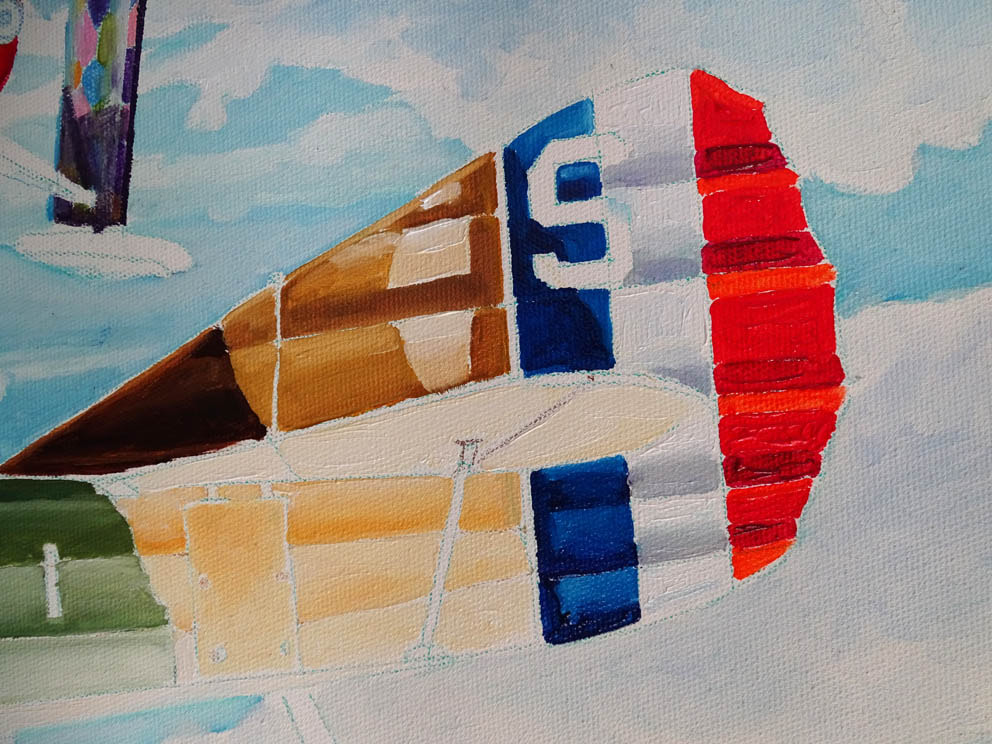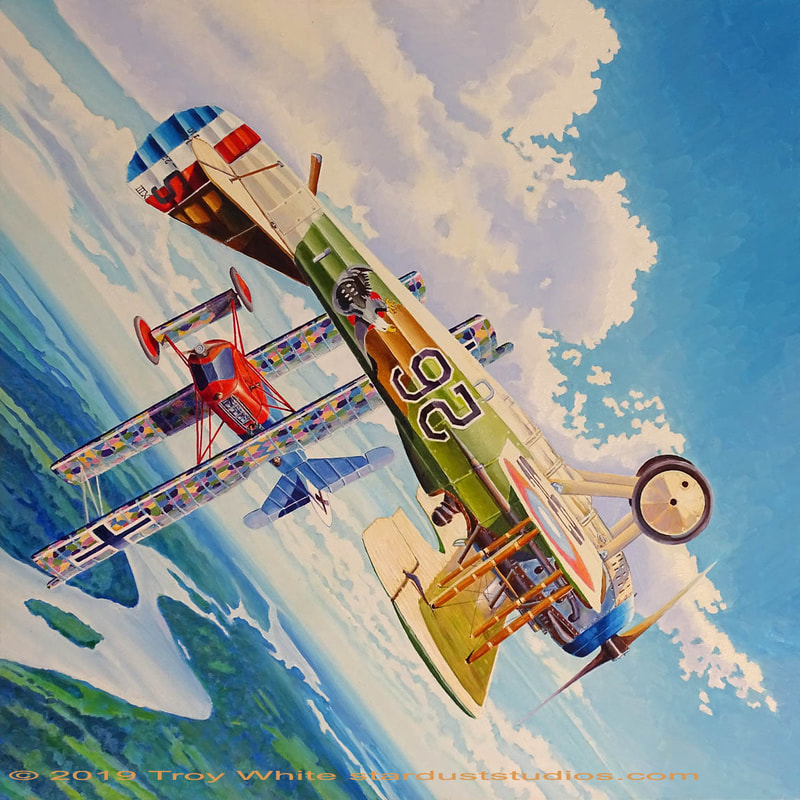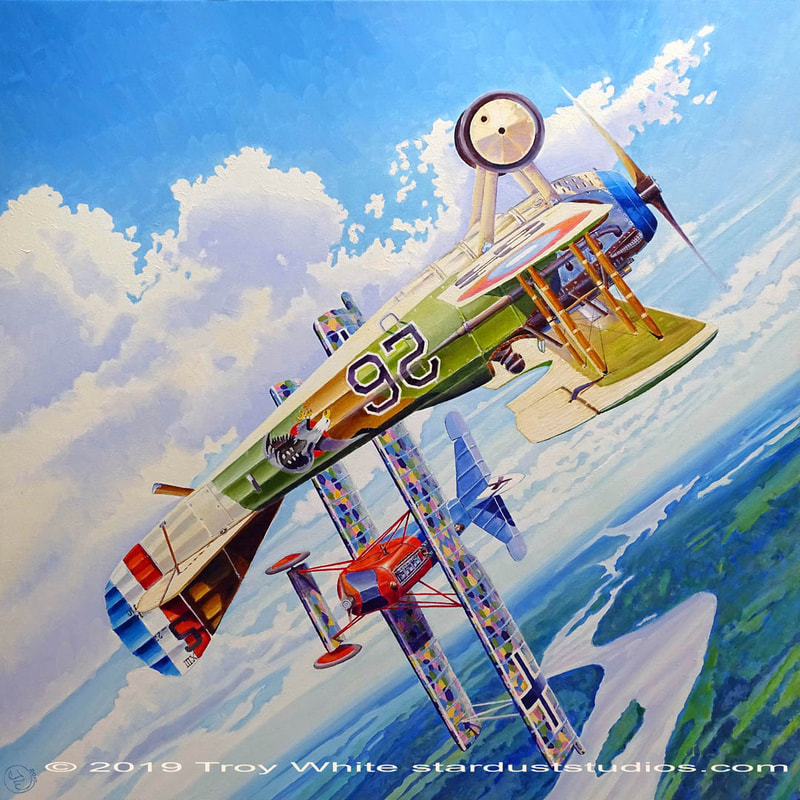Frank Luke Jr.
The Spectacular Air Fighter of the Great War
"La Ronde Des Lutins"
Oil on Canvas 30" x 30"
Troy White © 2019
Oil on Canvas 30" x 30"
Troy White © 2019
I have been wanting to do a WWI painting for several years and am finally getting around to it. This is my first painting depicting an American pilot of that time period. I decided back in 2012 to paint Frank Luke's Spad XIII. Just about every American school boy with a love of aviation has heard of Luke, the "Balloon Buster", the bad boy ace who disobeyed orders and went off hunting on his own and died a heroic death. Considering my affinity for his WWII counterpart Ralph Hofer it was only natural that I would eventually end up with Luke on my easel. Luke has been painted by many other artists but most, if not all portrayals of him in the air have featured him in his famous balloon busting role. I had toyed with the idea of putting a balloon in the composition but in the end I thought it would be better and more fun for me not to include a balloon but to show Frank in a dogfight with a German Fokker D VII. The title I've chosen for this painting is "La Ronde Des Lutins" (Dance of the Goblins) and is the title of a tune by world-renowned violinist Jascha Heifetz. It was a popular hit in 1918 which is when my painting takes place. I really like the tune and the name fits well with my composition.
Lt. Frank Luke has been called the most spectacular air fighter of the Great War. He had the hottest scoring streak ever notched up by an American fighter pilot. Between 12 September and 18 September 1918, he scored 13 confirmed victories. His final tally was four aeroplanes and fourteen balloons confirmed as destroyed. He also shot down three enemy planes which were unconfirmed, one on his first combat sortie and two on his last which were witnessed by French civilians. Frank Luke was enshrined in the National Aviation Hall of Fame in 1975. The following text is a quote from their website. The legendary dramatic death scene described has since been proven to be a fabrication but it makes for interesting reading nonetheless.
“In 1917, after the United States entered World War I against Germany, twenty-year old Frank Luke, Jr. of Phoenix, Arizona, enlisted in the Aviation Section, earned his wings and sailed for France. There his first assignment was to America’s famed 27th Aero Squadron in July 1918, and its commander told him that he could become an “Ace.” But a trip to the Front left a profound impression on Luke, as he saw scores of wrecked planes and pilots killed in dogfights with bullets in their backs. “They’ll never get me that way!” he vowed. Then he watched in fascination as a German plane shot down an American observation balloon. At that moment he seemed to set out to become America’s greatest balloon strafer.
August 18th: Luke engaged in his first aerial combat. Long after the squadron returned, he landed his bullet-riddled Spad and declared: “I’ve got a Fokker!” But his squadron mates doubted his claim. Only First Lieutenant Joseph Wehner believed him and they became inseparable friends. At this point Luke developed a daring plan for shooting down enemy balloons, in which he must scorn terrifying anti-aircraft fire, ignore enemy planes and attack without thought to his own safety.
September 12th: The great St. Mihiel offensive began and Luke stated: “I’m going after the balloons!” Wehner flew cover, while Luke dove and fired at his first balloon over Marieville. On his third pass, the balloon finally burst into flames. But his Spad took severe damage from anti-aircraft fire.
September 13th: A new plane was readied for Luke, equipped with special incendiary machine-guns. His mechanics worried when they saw a pistol strapped in his cockpit. He tells them: “I never will be taken prisoner!” That same day Luke proposed an even more daring plan to down enemy balloons, by attacking at dusk when antiaircraft fire was less accurate and the German planes protecting the balloons had retired for the day. He and Wehner were to act as a team, one to fly cover while the other attacked.
September 14th: Luke put his tactical invention to use when General Billy Mitchell called for the downing of two balloons in a few hours. On the morning patrol, Luke dove at a balloon near Boinville. But he had to ignore repeated antiaircraft hits before the balloon went down on the sixth pass. On the afternoon patrol, Luke and Wehner struck at the balloon near Buzy. When they dove, Luke’s first bullets hit their mark and the balloon exploded. They soon spotted another balloon but enemy Fokkers halted their attack. In the melee, Luke’s guns jammed and, as he dove for safety, their bullets riddled his Spad. Minutes later, he landed and begged for another plane to go after more balloons. But his commanding officer refused, saying: “I’m proud of you, Frank. You have just done the impossible!” Later, Billy Mitchell arrived to add his congratulations and to hear Luke’s plan for strafing balloons at dusk. Luke informed Billy: “If you return tomorrow evening, you’ll see two more balloons burn up!”
September 15th: in the morning Luke sent two balloons near Boinville to the ground in flames. But when Mitchell arrived to witness Luke and Wehner down two balloons at a promised 6:58 P.M., he said: “It’s impossible!” To down a balloon at all was a feat. All of a sudden there was a huge explosion in the sky near Spincourt. Moments later, Mitchell yelled: “My God! There goes the other!” Luke had destroyed both balloons. When he and Wehner landed, they received congratulations from Mitchell and other officers. “We’ll burn them as fast as they put them up!” Luke promised.
September 16th: When orders were issued to strafe three balloons hanging beyond St. Mihiel, Luke said: “The first one will go up in flames at exactly 7:05.” Few believed they could reach the balloons, but at exactly 7:05 Luke and Wehner dove and fired at a balloon near Reville. “There goes the first one!,” somebody shouted. Then they turned toward Romagne and almost to the second, at 7:21, a gigantic burst appeared. Luke had downed the second balloon. Finally, at 7:35, the sky erupted for the third time, as Wehner downed another balloon. As for Luke, his record stood at an incredible nine balloons.
Lt. Frank Luke has been called the most spectacular air fighter of the Great War. He had the hottest scoring streak ever notched up by an American fighter pilot. Between 12 September and 18 September 1918, he scored 13 confirmed victories. His final tally was four aeroplanes and fourteen balloons confirmed as destroyed. He also shot down three enemy planes which were unconfirmed, one on his first combat sortie and two on his last which were witnessed by French civilians. Frank Luke was enshrined in the National Aviation Hall of Fame in 1975. The following text is a quote from their website. The legendary dramatic death scene described has since been proven to be a fabrication but it makes for interesting reading nonetheless.
“In 1917, after the United States entered World War I against Germany, twenty-year old Frank Luke, Jr. of Phoenix, Arizona, enlisted in the Aviation Section, earned his wings and sailed for France. There his first assignment was to America’s famed 27th Aero Squadron in July 1918, and its commander told him that he could become an “Ace.” But a trip to the Front left a profound impression on Luke, as he saw scores of wrecked planes and pilots killed in dogfights with bullets in their backs. “They’ll never get me that way!” he vowed. Then he watched in fascination as a German plane shot down an American observation balloon. At that moment he seemed to set out to become America’s greatest balloon strafer.
August 18th: Luke engaged in his first aerial combat. Long after the squadron returned, he landed his bullet-riddled Spad and declared: “I’ve got a Fokker!” But his squadron mates doubted his claim. Only First Lieutenant Joseph Wehner believed him and they became inseparable friends. At this point Luke developed a daring plan for shooting down enemy balloons, in which he must scorn terrifying anti-aircraft fire, ignore enemy planes and attack without thought to his own safety.
September 12th: The great St. Mihiel offensive began and Luke stated: “I’m going after the balloons!” Wehner flew cover, while Luke dove and fired at his first balloon over Marieville. On his third pass, the balloon finally burst into flames. But his Spad took severe damage from anti-aircraft fire.
September 13th: A new plane was readied for Luke, equipped with special incendiary machine-guns. His mechanics worried when they saw a pistol strapped in his cockpit. He tells them: “I never will be taken prisoner!” That same day Luke proposed an even more daring plan to down enemy balloons, by attacking at dusk when antiaircraft fire was less accurate and the German planes protecting the balloons had retired for the day. He and Wehner were to act as a team, one to fly cover while the other attacked.
September 14th: Luke put his tactical invention to use when General Billy Mitchell called for the downing of two balloons in a few hours. On the morning patrol, Luke dove at a balloon near Boinville. But he had to ignore repeated antiaircraft hits before the balloon went down on the sixth pass. On the afternoon patrol, Luke and Wehner struck at the balloon near Buzy. When they dove, Luke’s first bullets hit their mark and the balloon exploded. They soon spotted another balloon but enemy Fokkers halted their attack. In the melee, Luke’s guns jammed and, as he dove for safety, their bullets riddled his Spad. Minutes later, he landed and begged for another plane to go after more balloons. But his commanding officer refused, saying: “I’m proud of you, Frank. You have just done the impossible!” Later, Billy Mitchell arrived to add his congratulations and to hear Luke’s plan for strafing balloons at dusk. Luke informed Billy: “If you return tomorrow evening, you’ll see two more balloons burn up!”
September 15th: in the morning Luke sent two balloons near Boinville to the ground in flames. But when Mitchell arrived to witness Luke and Wehner down two balloons at a promised 6:58 P.M., he said: “It’s impossible!” To down a balloon at all was a feat. All of a sudden there was a huge explosion in the sky near Spincourt. Moments later, Mitchell yelled: “My God! There goes the other!” Luke had destroyed both balloons. When he and Wehner landed, they received congratulations from Mitchell and other officers. “We’ll burn them as fast as they put them up!” Luke promised.
September 16th: When orders were issued to strafe three balloons hanging beyond St. Mihiel, Luke said: “The first one will go up in flames at exactly 7:05.” Few believed they could reach the balloons, but at exactly 7:05 Luke and Wehner dove and fired at a balloon near Reville. “There goes the first one!,” somebody shouted. Then they turned toward Romagne and almost to the second, at 7:21, a gigantic burst appeared. Luke had downed the second balloon. Finally, at 7:35, the sky erupted for the third time, as Wehner downed another balloon. As for Luke, his record stood at an incredible nine balloons.
September 18th: Luke and Wehner took off to attack balloons east of Verdun. It would prove to be their last flight together, as Luke dove three times to down a balloon near Labeuville. Suddenly, six Fokkers bore down on Luke. With great daring, he raced toward a second balloon, before they could intercept him, and sent the balloon down in towering flames. Then Luke caught sight of Wehner’s plane falling earthward in flames. Luke’s best friend had been shot down while trying to protect him, a courageous act of self-sacrifice! Consumed with fury, Luke turned on Wehner’s attackers and in less than ten seconds shot down two of them! Then, as he flew toward Verdun, he spotted a German observation plane. Roaring down out of the sky, he opened fire and the enemy plane fell off in a spin and crashed. Frank Luke had shot down two balloons and three planes in less than ten minutes, an incredible feat never to be equalled in the history of warfare!
September 19th: The First Pursuit Group held a dinner in Luke’s honor. At this point, he now had fourteen officially confirmed victories, surpassing Eddie Rickenbacker and was hailed as America’s new “Ace of Aces.” Later Rickenbacker would write: “There never has been an aviator who possessed the confidence, ability and courage that Frank Luke had shown during those remarkable two weeks.” But the loss of Wehner and the fatigue of battle were taking their toll on Luke. He grew morbid and silent and finally received a seven day rest leave.
September 26th: When the Allies launched their massive Argonne-Meuse offensive, Luke’s commanding officer told him: “I’ll give you enough protection to run your string to a hundred. Only be careful!” “Don’t worry,” replied Luke, “They can’t get me!”. That day Luke bagged another Fokker.
September 27th: Luke teamed up with Lieutenants Ivan Roberts and Alden Sherry to strafe balloons. Instead, they ran into five Fokkers. In the bitter dogfight that ensued, Luke got an unconfirmed victory, but Roberts was never seen again and Sherry was shot down near the American lines. That night, after Luke got another unconfirmed balloon victory, he deliberately spent the night at the Toul airdrome, where the French treated him like a king. But his commanding officer considered him “absent without leave.”
September 28th: When Luke returned to his own airdrome the next morning, his commander severely reprimanded him. Angered and upset, he took off without permission and headed for an enemy balloon near Bethenville. By this point Luke seemed to believe that he was invincible. In the last combat report he ever made, Luke writes: “I flew north to Verdun and found a balloon in its nest near Bethenville. Later that day, he took off again, without authorization, and spent the night again with the French squadron.
September 29th: Soon after Luke’s commanding officer grounded him, Luke took off and headed for three balloons near Dun-Sur-Meuse. As he flew low over the American balloon headquarters, he dropped a message that read: “Watch three Hun balloons over the Meuse. Luke.” Minutes later a red glow filled the sky. Luke had downed the first balloon. What happened to Frank Luke after that is still unknown. But he would never return from this mission. Historians will always view with a degree of mystery the fate of Frank Luke, Jr. Not until 1919 did authorities locate his unmarked grave near the village of Murvaux, France. From an affidavit that the village residents signed, it appears that enemy Fokkers jumped Luke. He shot down two before being severely wounded in the shoulder. Eluding his attackers, Luke downed two more balloons. But his Spad began losing altitude. When he reached Murvaux, he swooped down and strafed troops in the streets, killing six and wounding many more. Then he made a forced landing, crawled out and headed for a nearby stream, apparently to get water to treat his wound. But German infantrymen intercepted him and ordered him to surrender. Frank Luke, Jr. could have honorably surrendered and become a prisoner. Instead, he drew his pistol and fired at the infantrymen, killing seven before he went down with a great wound in his chest. The enemy had killed Frank Luke, Jr. That was the most they could do, for they could not defeat him in the air.
Frank Luke, Jr., the “Arizona Balloon Buster,” was one of the bravest men ever to wear the wings of the Aviation Section. He possessed a unique combination of shyness and aggression, plus an honest dislike for excessive discipline. But not one ever questioned his courage in the air as his career increased in brilliance. In any other branch of service, he would have been unhappy. In the Aviation Section he found expression in the freedom of flight.”
Frank Luke was awarded the Congressional Medal of Honor for his actions on 29 September 1918. He was also awarded two Distinguished Service Crosses for extraordinary heroism in air action in the face of heavy enemy fire. He was only 21 years old when he was killed. On Armistice Day 1930, (now called Veterans Day in the USA) a bronze statue of Lt. Frank Luke, Jr. was unveiled on the capitol grounds in Phoenix, Arizona. From 1919 to 1932, Luke Field, Territory of Hawaii, was named after Luke In June 1949, the Army Air Base near Phoenix was named Luke AFB in his honour.
September 19th: The First Pursuit Group held a dinner in Luke’s honor. At this point, he now had fourteen officially confirmed victories, surpassing Eddie Rickenbacker and was hailed as America’s new “Ace of Aces.” Later Rickenbacker would write: “There never has been an aviator who possessed the confidence, ability and courage that Frank Luke had shown during those remarkable two weeks.” But the loss of Wehner and the fatigue of battle were taking their toll on Luke. He grew morbid and silent and finally received a seven day rest leave.
September 26th: When the Allies launched their massive Argonne-Meuse offensive, Luke’s commanding officer told him: “I’ll give you enough protection to run your string to a hundred. Only be careful!” “Don’t worry,” replied Luke, “They can’t get me!”. That day Luke bagged another Fokker.
September 27th: Luke teamed up with Lieutenants Ivan Roberts and Alden Sherry to strafe balloons. Instead, they ran into five Fokkers. In the bitter dogfight that ensued, Luke got an unconfirmed victory, but Roberts was never seen again and Sherry was shot down near the American lines. That night, after Luke got another unconfirmed balloon victory, he deliberately spent the night at the Toul airdrome, where the French treated him like a king. But his commanding officer considered him “absent without leave.”
September 28th: When Luke returned to his own airdrome the next morning, his commander severely reprimanded him. Angered and upset, he took off without permission and headed for an enemy balloon near Bethenville. By this point Luke seemed to believe that he was invincible. In the last combat report he ever made, Luke writes: “I flew north to Verdun and found a balloon in its nest near Bethenville. Later that day, he took off again, without authorization, and spent the night again with the French squadron.
September 29th: Soon after Luke’s commanding officer grounded him, Luke took off and headed for three balloons near Dun-Sur-Meuse. As he flew low over the American balloon headquarters, he dropped a message that read: “Watch three Hun balloons over the Meuse. Luke.” Minutes later a red glow filled the sky. Luke had downed the first balloon. What happened to Frank Luke after that is still unknown. But he would never return from this mission. Historians will always view with a degree of mystery the fate of Frank Luke, Jr. Not until 1919 did authorities locate his unmarked grave near the village of Murvaux, France. From an affidavit that the village residents signed, it appears that enemy Fokkers jumped Luke. He shot down two before being severely wounded in the shoulder. Eluding his attackers, Luke downed two more balloons. But his Spad began losing altitude. When he reached Murvaux, he swooped down and strafed troops in the streets, killing six and wounding many more. Then he made a forced landing, crawled out and headed for a nearby stream, apparently to get water to treat his wound. But German infantrymen intercepted him and ordered him to surrender. Frank Luke, Jr. could have honorably surrendered and become a prisoner. Instead, he drew his pistol and fired at the infantrymen, killing seven before he went down with a great wound in his chest. The enemy had killed Frank Luke, Jr. That was the most they could do, for they could not defeat him in the air.
Frank Luke, Jr., the “Arizona Balloon Buster,” was one of the bravest men ever to wear the wings of the Aviation Section. He possessed a unique combination of shyness and aggression, plus an honest dislike for excessive discipline. But not one ever questioned his courage in the air as his career increased in brilliance. In any other branch of service, he would have been unhappy. In the Aviation Section he found expression in the freedom of flight.”
Frank Luke was awarded the Congressional Medal of Honor for his actions on 29 September 1918. He was also awarded two Distinguished Service Crosses for extraordinary heroism in air action in the face of heavy enemy fire. He was only 21 years old when he was killed. On Armistice Day 1930, (now called Veterans Day in the USA) a bronze statue of Lt. Frank Luke, Jr. was unveiled on the capitol grounds in Phoenix, Arizona. From 1919 to 1932, Luke Field, Territory of Hawaii, was named after Luke In June 1949, the Army Air Base near Phoenix was named Luke AFB in his honour.
Congressional Medal of Honor
Citation:
After having previously destroyed a number of enemy aircraft within 17 days he voluntarily started on a patrol after German observation balloons. Though pursued by 8 German planes which were protecting the enemy balloon line, he unhesitatingly attacked and shot down in flames 3 German balloons, being himself under heavy fire from ground batteries and the hostile planes. Severely wounded, he descended to within 50 meters of the ground, and flying at this low altitude near the town of Murvaux opened fire upon enemy troops, killing 6 and wounding as many more. Forced to make a landing and surrounded on all sides by the enemy, who called upon him to surrender, he drew his automatic pistol and defended himself gallantly until he fell dead from a wound in the chest.
Luke statue, Phoenix, Arizona, Roger Noble Burnham, sculptor, 1930
First Distinguished Service Cross
Citation:
The President of the United States of America, authorized by Act of Congress, July 9, 1918, takes pride in presenting the Distinguished Service Cross (Posthumously) to Second Lieutenant (Air Service) Frank Luke, Jr., United States Army Air Service, for extraordinary heroism in action while serving with 27th Aero Squadron, 1st Pursuit Group, U.S. Army Air Service, A.E.F., near St. Mihiel, France, September 12 to 15, 1918. Lieutenant Luke, by skill, determination, and bravery, and in the face of heavy enemy fire, successfully destroyed eight enemy observation balloons in four days.
Second Distinguished Service Cross
Citation:
The President of the United States of America, authorized by Act of Congress, July 9, 1918, takes pride in presenting a Bronze Oak Leaf Cluster in lieu of a Second Award of the Distinguished Service Cross (Posthumously) to Second Lieutenant (Air Service) Frank Luke, Jr., United States Army Air Service, for extraordinary heroism in action while serving with 27th Aero Squadron, 1st Pursuit Group, U.S. Army Air Service, A.E.F., near Etain, France, 18 September 1918. Immediately after destroying two enemy observation balloons, Lieutenant Luke was attacked by a large formation of German planes, Fokker type. He turned to attack two, which were directly behind him, and shot them down. Sighting an enemy biplane, although his gasoline was nearly gone, he attacked and destroyed this machine also.
Citation:
After having previously destroyed a number of enemy aircraft within 17 days he voluntarily started on a patrol after German observation balloons. Though pursued by 8 German planes which were protecting the enemy balloon line, he unhesitatingly attacked and shot down in flames 3 German balloons, being himself under heavy fire from ground batteries and the hostile planes. Severely wounded, he descended to within 50 meters of the ground, and flying at this low altitude near the town of Murvaux opened fire upon enemy troops, killing 6 and wounding as many more. Forced to make a landing and surrounded on all sides by the enemy, who called upon him to surrender, he drew his automatic pistol and defended himself gallantly until he fell dead from a wound in the chest.
Luke statue, Phoenix, Arizona, Roger Noble Burnham, sculptor, 1930
First Distinguished Service Cross
Citation:
The President of the United States of America, authorized by Act of Congress, July 9, 1918, takes pride in presenting the Distinguished Service Cross (Posthumously) to Second Lieutenant (Air Service) Frank Luke, Jr., United States Army Air Service, for extraordinary heroism in action while serving with 27th Aero Squadron, 1st Pursuit Group, U.S. Army Air Service, A.E.F., near St. Mihiel, France, September 12 to 15, 1918. Lieutenant Luke, by skill, determination, and bravery, and in the face of heavy enemy fire, successfully destroyed eight enemy observation balloons in four days.
Second Distinguished Service Cross
Citation:
The President of the United States of America, authorized by Act of Congress, July 9, 1918, takes pride in presenting a Bronze Oak Leaf Cluster in lieu of a Second Award of the Distinguished Service Cross (Posthumously) to Second Lieutenant (Air Service) Frank Luke, Jr., United States Army Air Service, for extraordinary heroism in action while serving with 27th Aero Squadron, 1st Pursuit Group, U.S. Army Air Service, A.E.F., near Etain, France, 18 September 1918. Immediately after destroying two enemy observation balloons, Lieutenant Luke was attacked by a large formation of German planes, Fokker type. He turned to attack two, which were directly behind him, and shot them down. Sighting an enemy biplane, although his gasoline was nearly gone, he attacked and destroyed this machine also.
